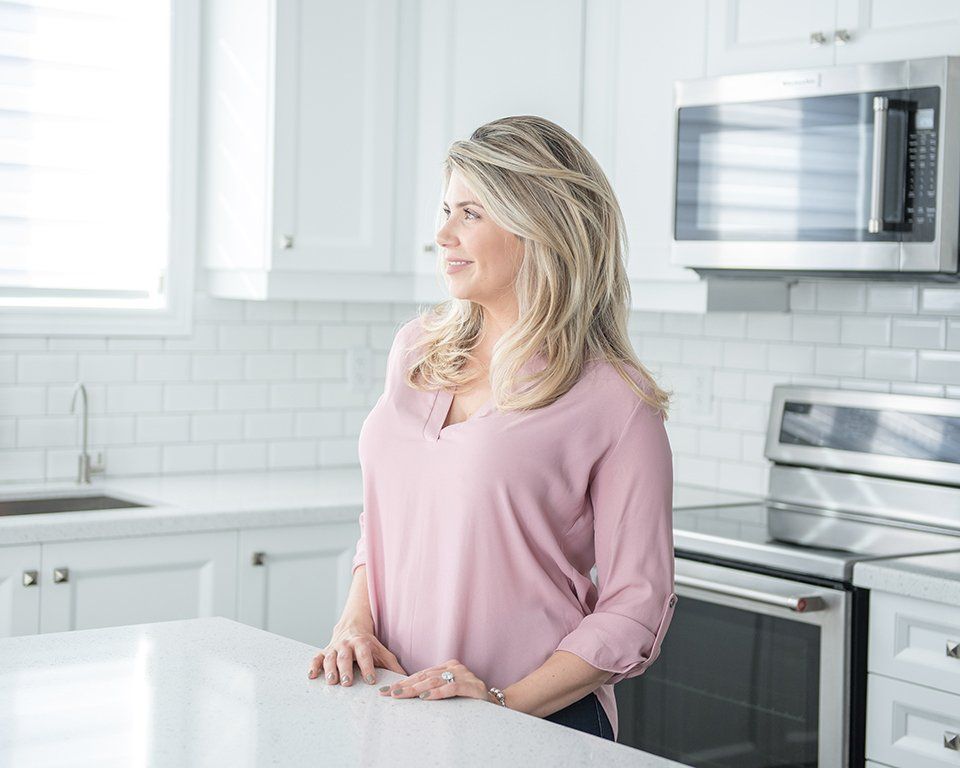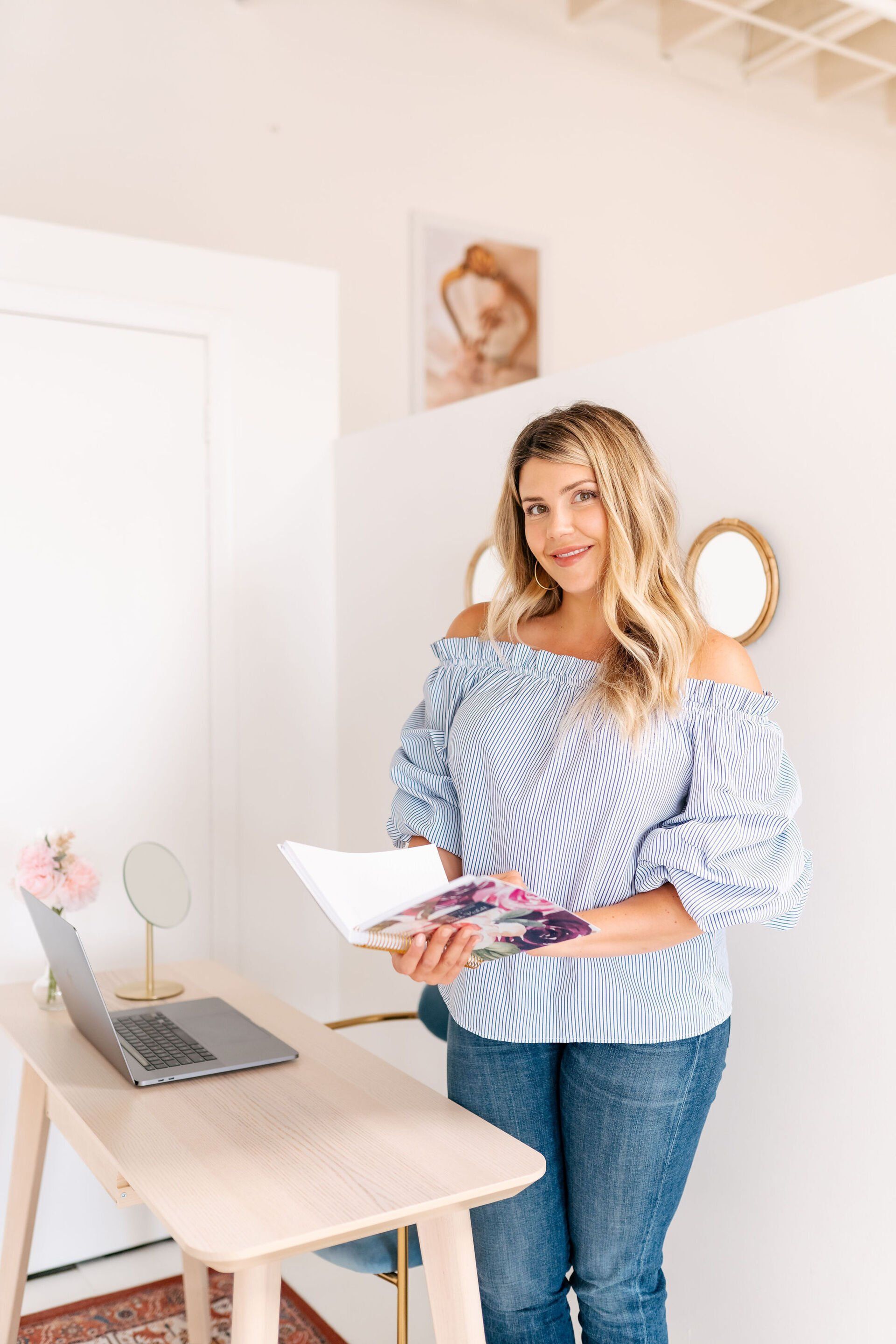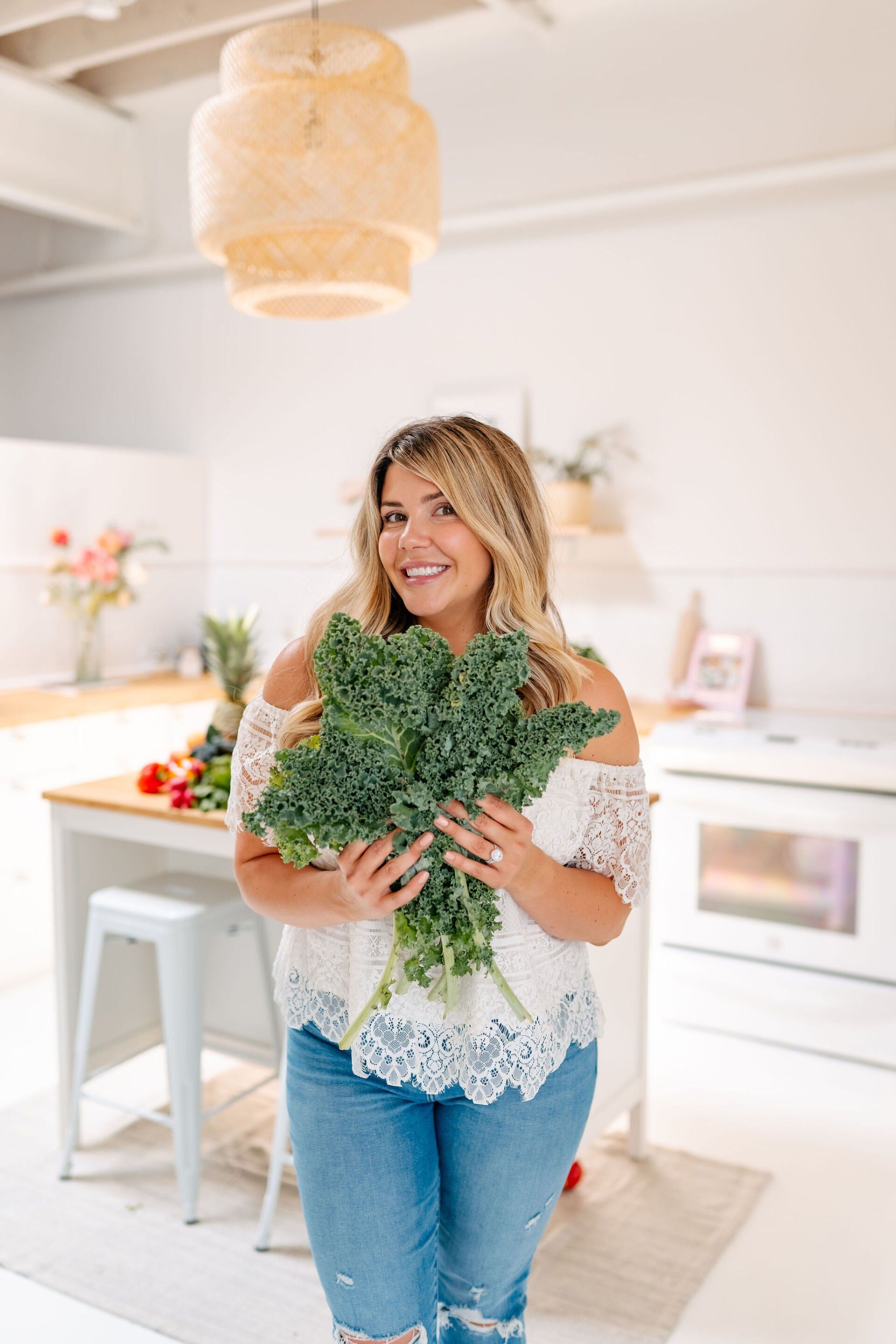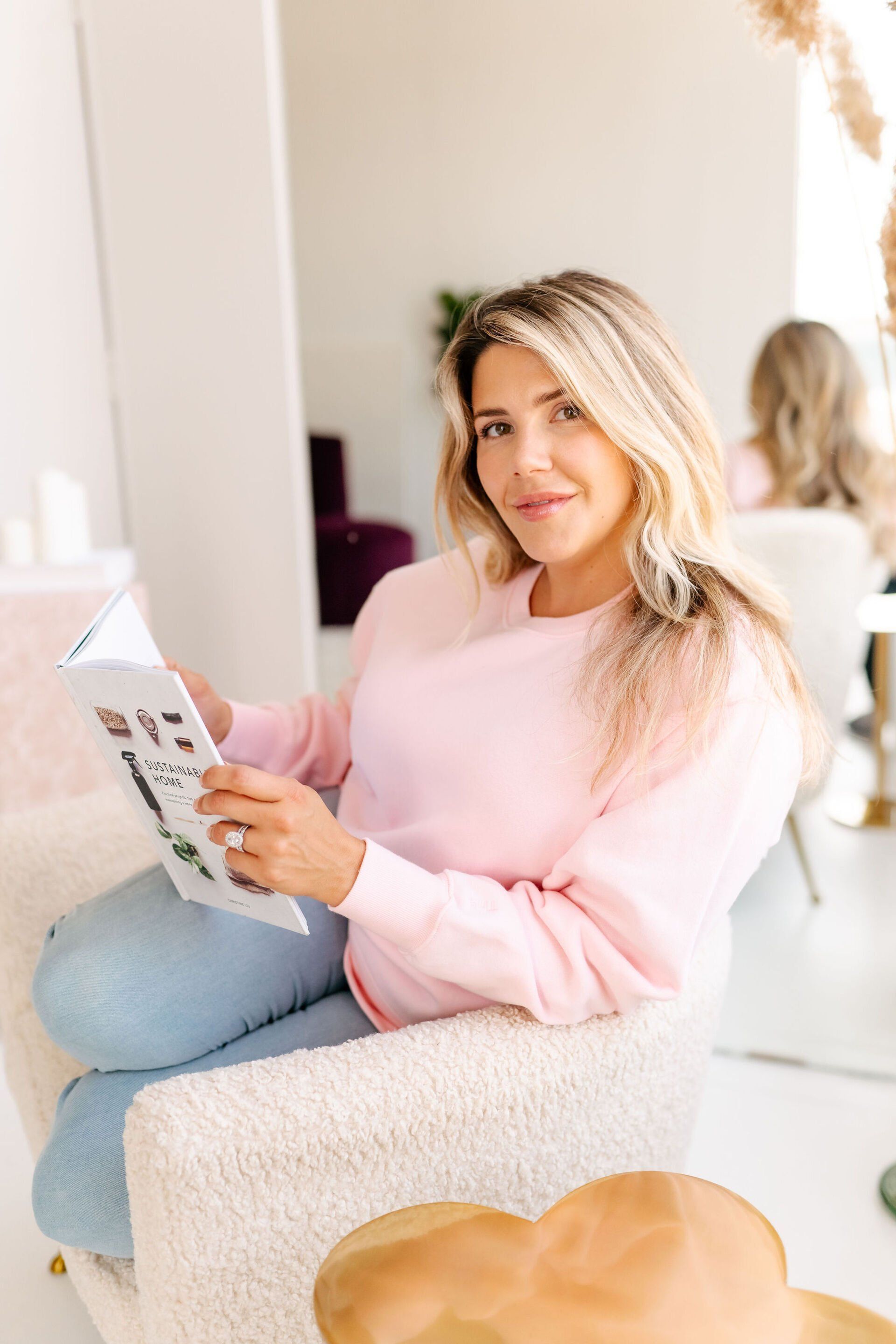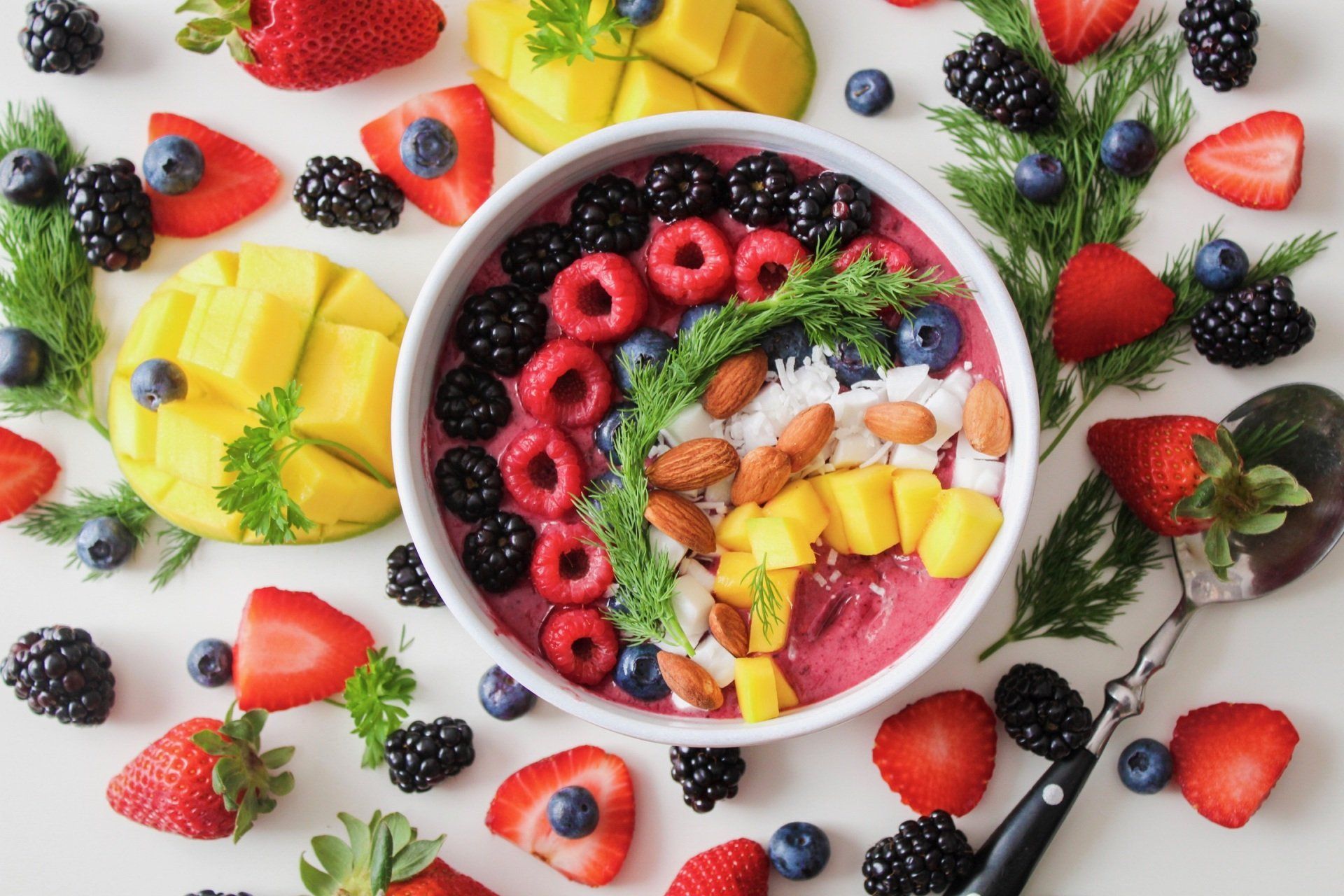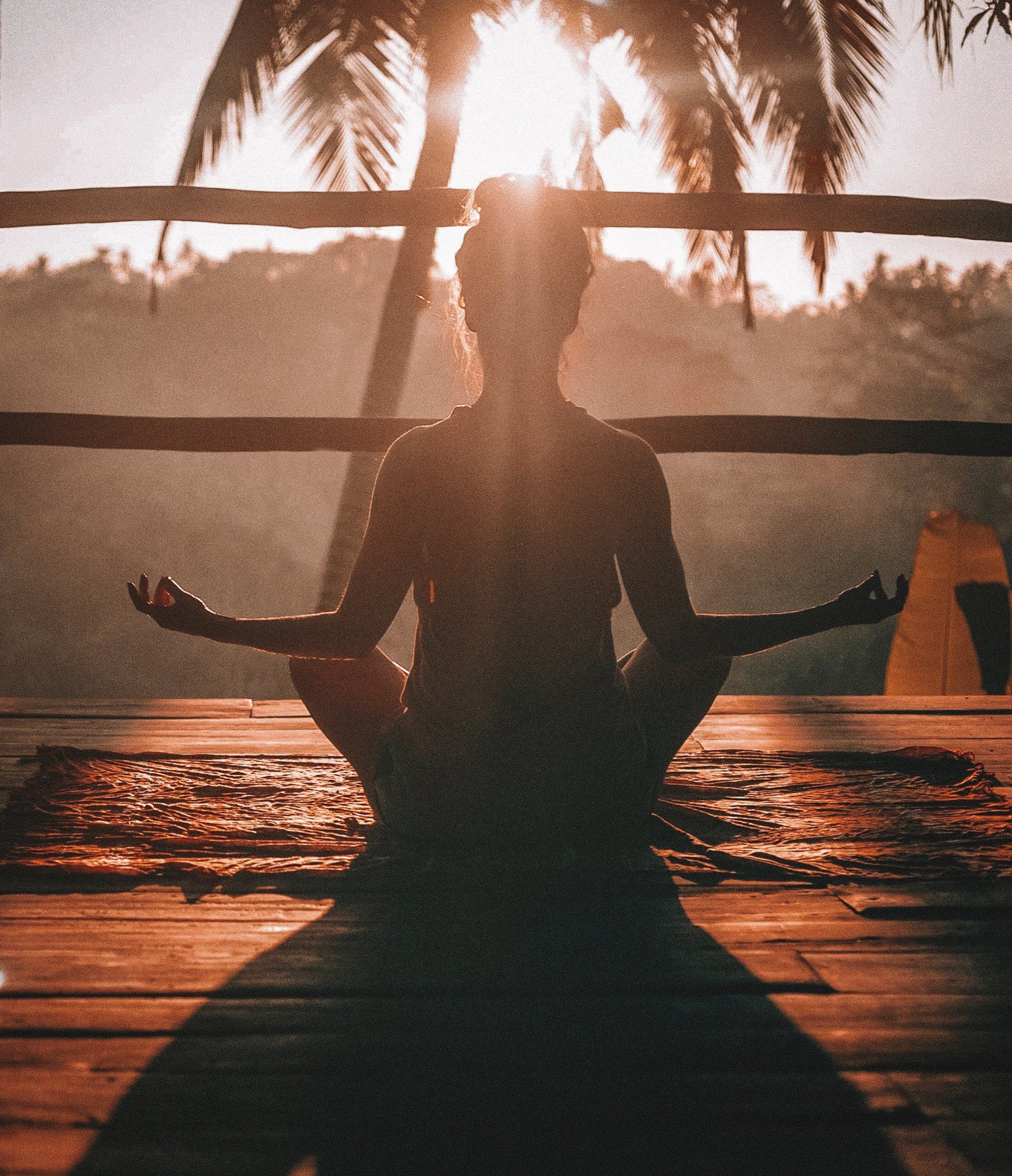Blog
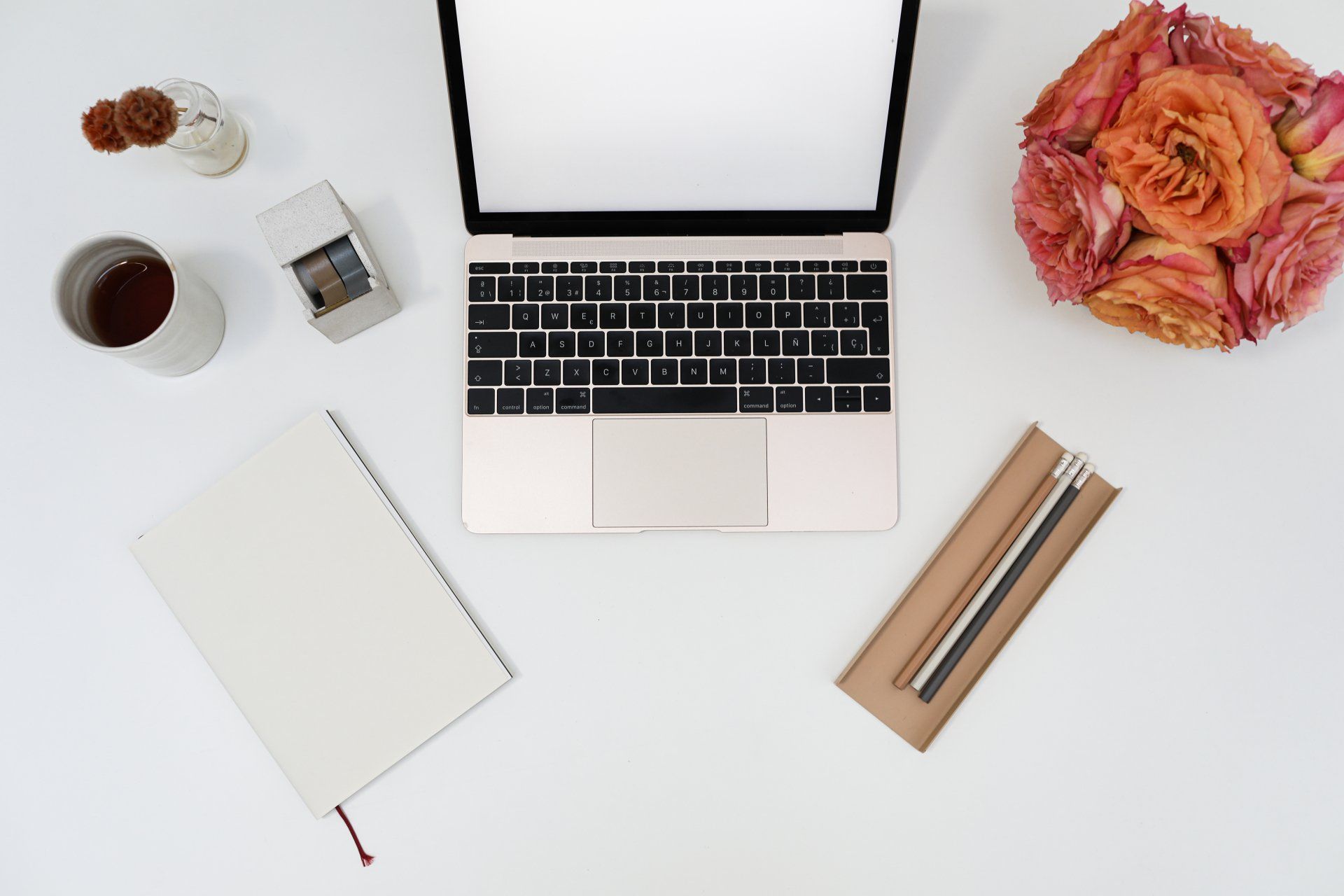
By Sarah Parlett
•
January 25, 2022
Lately I have found myself spending more time than ever on my devices whether it is my phone, computer, or tablet. There is always room for improvement when it comes to my screen time. If you find yourself unproductive, overly stressed, or anxious it might be time for a digital detox. This can mean several different things. It can be completely withdrawing from technology, limiting the amount of time using technology, or minimizing your exposure to electromagnetic fields (EMF’s). It is not practical to remove all technology in your life but making small shifts can support positive change in your well-being. 10 benefits from “unplugging” and doing a digital detox: 1. Reduce stress. 2. Reconnect with the world and people around you. 3. Boost productivity. 4. Reduce restlessness and improve sleep. 5. More time for yourself. 6. Improve physical health. 7. Improve mental health. 8. Increase attention span. 9. Improve work/life balance. 10. Discover new hobbies. Overall, you will enjoy life more. You will be in the moment, feel connected to the world and others around you, be happier and healthier with more time to do the things you enjoy and that really matter. Here are some tips and tools for creating healthy digital habits: Select one day a week to unplug from devices. This will encourage you to get outside, try something new, and focus on the things and people you love. It also gives you the opportunity to tune inward and honour your personal self-care needs. Set social boundaries. Limit bringing your phone out when you’re having face-to-face social interactions. You will be more present with family and friends allowing for undivided attention and deeper connection. Remove notifications. They are one of the main reasons we reach for our phones so frequently. I have notifications turned off on all of my social media platforms and silence my phone at night. Set a time limit on your phone for daily use. Try not to use electronics one or two hours before bed, or wait one hour after waking up before turning to screens. This will break the habit of constantly depending on them. An example: set an alarm at 8:00 pm to remind you to put your phone away for the night. You can also use Screen Time tracking on the iPhone or download an app to help monitor your daily time on your phone. Be mindful of what you consume. Take note of how you feel when you are on social media apps. Do the people you follow bring you joy and inspiration, or are you feeling down? I hope these simple tips and reminders can help you live more mindfully. I am personally overdue for a digital detox. The onset of a new year brings a sense of change in the air. I think it is a perfect time to consider unplugging and spending more time outdoors connecting with family and nature. Have you ever done a digital detox? If so, how did it feel?
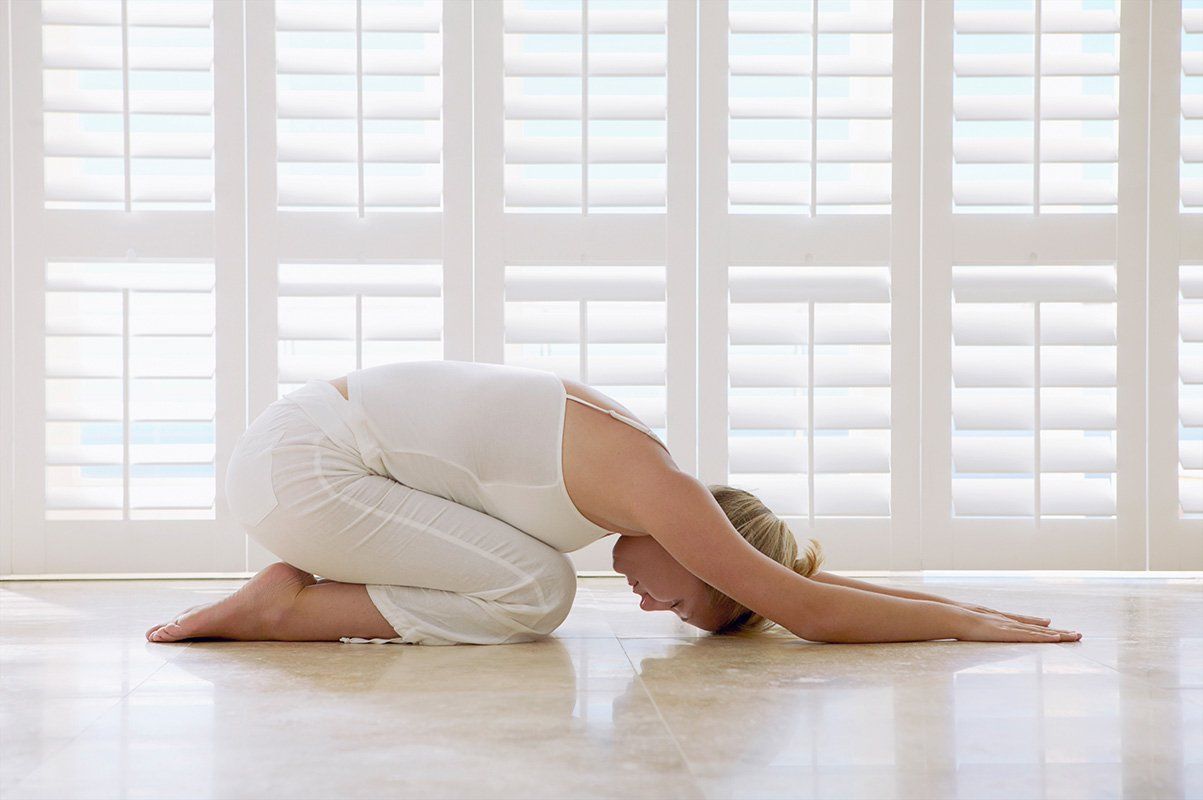
By Sarah Parlett
•
January 17, 2022
The gut is not only the key to health, but the key to happiness as well. It plays a role in stress modulation by transmitting signals to and from the brain via neurotransmitters, along the vagus nerve. The vagus nerve is the biggest nerve in the body, extending all the way from the brain stem to the intestines and branching out to connect the major organs. When the vagus nerve is stimulated, it activates the parasympathetic nervous system and the body’s “rest and digest” response. Engaging in activities that wake up the vagus nerve, strengthen it and disrupt the “fight or flight” response of the sympathetic nervous system. Regularly exercising the vagus nerve promotes a strong and healthy vagal tone, which helps ward off the negative effects of stress. Supporting and stimulating the vagus nerve is a great way to support optimal gut health. Here are 7 activities that can support a healthy vagal tone. 1. Alternate Nostril Breathing Pranayama refers to yogic breath work. Here is a simple pranayama exercise you can do anywhere: - place your right thumb on the outside of your right nostril, closing it off. - inhale fully through your left nostril. - Holding the breath, use your right ring finger to close off your left nostril and remove your thumb from your right nostril. - Exhale fully through your right nostril. - Keeping your ring finger on your left nostril, inhale fully through your right nostril. - Holding at the top of the breath, switch fingers again, putting your thumb on the outside of your right nostril and removing the ring finger from the left. - Exhale fully through your left nostril. This is one round. Continue for 5-10 rounds, or until you feel relaxed. 2. Cold Plunge The cold plunge is a practice that exists in many culture. It is done to help build the immune system by increasing resilience to stress (the shock of going from hot to cold) and supporting the body’s ability to transition between the sympathetic and parasympathetic nervous systems. To do a cold plunge, immerse your body in warm water for five minutes. Then immediately transition to cold water for 20 seconds. A less drastic approach is to rinse your face with very cold water right after a hot shower or bath. Many spas such as the Scandinave Spa, have hot and cold plunge pools you can dip in and out of. 3. Deep Breathing Creating a practice of slowly and fully inhaling and exhaling each breath helps slow down your body and combat stress, activating the parasympathetic nervous system and stimulating the vagus nerve. Although it isn’t realistic to breathe like this all of the time, when you catch yourself feeling overwhelmed or stressed out, bring your focus back to your breath. I suggest you try to add a deep breathing practice before bedtime, even if it’s just 5-10 minutes a day. A small change in your daily habits can create a profound shift in your nervous system and stress levels. 4. Gentle Movement Walking or doing yoga are great ways to gently move the body and stimulate the vagus nerve through calming exercise. Here is a short yoga sequence for the vagus nerve: - Several rounds of sun salutations - Sun salutation leading into crescent pose - Sun salutation leading into chair pose with a twist and arms stretched wide - Triangle pose - Reverse Warrior Pose - Cat stretch - Reverse tabletop - Legs up the wall - Reclined twist to the right and left 5. Laughter Laugher can stimulate the vagus nerve and have positive effects on heart rate. As I am sure you’ve heard – laughter is the best medicine! Especially a deep belly laugh. How can you add more laughter into your daily life? Do you take time to watch funny television shows or movies? Do you spend time with people who crack you up? Switch an educational podcase for a stand-up comedy routine a few times a week? Take some time to find your funny. 6. Meditation Meditation has a positive effect on stress, mood, and heart rate which support the parasympathetic nervous system. Even 5-10 minutes a day can have a significant effect. Find a meditation practice that works best for you – whether it involves using an app or a guided meditation, sitting quietly in nature or lighting a candle and resting your gaze on it. Meditation is bio-individual. 7. Positive Sounds Releasing positive tones through your vocal cords can stimulate the vagus nerve. This can be done through singing, humming, or chanting. Can you sing in the shower or in the car on your way to work? Find out what resonates with you. You can pick and choose from the list or incorporate all of them into your routine! Pay attention to your stress levels and the feelings in your body. Find time to relax, de-stress, and do what feels right for you!

By Sarah Parlett
•
January 17, 2022
Diet, genetics, and medical history are often the first to come to mind when considering factors that influence gut health. But stress is one of the biggest disturbances to digestion and the health of the gut microbiome. In fact, stress has been linked to many digestive health issues, including gastric reflux and irritable bowel syndrome (IBS). Therefore, stress management and self-care are important components of healing the gut and working toward optimal digestive health. It doesn’t matter how much kale and broccoli you eat – if stress is also on your plate, it will impact your body’s ability to properly digest food and absorb nutrients. Learning how to soothe and quiet the stress response before and during meals takes practice and can feel challenging – especially when life feels chaotic. A powerful way to keep stress off your plate is to adopt a practice of mindful eating. Mindful eating is the act of being fully present to all your senses as you eat. It includes an awareness of your thoughts, without judgment, and an account of how you’re feeling physically and emotionally before, during, and after meals. Engaging in mindful eating has many benefits, from developing a healthy relationship with food to supporting food choices that are aligned with your health goals. When looking at gut health specifically, mindful eating can transform the mealtime experience into an opportunity to maximize digestion. Mindful eating practices allow us to shift out of “fight or flight” mode in our sympathetic nervous system and instead activate the “rest and digest” mode in the parasympathetic nervous system. There are many ways to make this switch. Taking a moment to express gratitude or taking several deep breaths ahead of a meal sets the stage for a relaxing dining experience. This relaxation allows your body to focus (or single-task) all its energy on digestion. Being present with your food helps prevent stress-inducing distractions from sneaking in. Not only does multitasking while eating shift focus away from your food, but it’s likely to create additional stress as well, as the practice often leads to disjointed thinking and frustration upon interruptions. Here are some “mealtime makeovers” to empower you to de-stress your plates. With a few simple shifts, and regular practice, these small changes can have a large impact on how you digest your food, which may help improve your overall digestive health. Instead of: Slouching over the counter, eating out of a box in front of the pantry, or eating standing up in the kitchen Try this: Practice sitting down to enjoy a meal. Posture has a big effect on how well you digest what you eat. Sitting while eating slows the movement of food through the stomach, allowing for optimal digestion. Think of it this way: instead of sending energy to your legs while eating, it’s better to reserve it for your gut. Instead of: rapidly scarfing down lunch Try This: Ideally, try to make your meals last at least 20 minutes. I encourage you to take smaller bites and take time to chew properly, which can prevent GI distress from poorly chewed food and swallowing air (hello bloating!). Even taking just a few extra minutes to enjoy your meal will go a long way. Instead of : Jumping right into a meal while frazzled, anxious, or stressed Try This : Consider taking a few breaths, briefly meditating, or reflecting on gratitude before sitting down to eat. If you’re coming from a stressful situation, take a few moments to yourself before engaging in a meal. Instead of: Scrolling through your phone or watching television while you eat Try This: Make mealtimes a tech-free zone. It’s okay to shut down and log off, especially while eating. This will encourage you to be present to all the senses as you eat. How does your food smell? What colours do you see on your plate? How does the texture of the food feel on your tongue? Instead of: Reaching for food when you’re not physically hungry Try This: Whenever you feel the urge to eat, check in with yourself. Do you feel any physical sensations of hunger or has another emotion bubbled up, leading you to fill an unmet need with food? For example, if you’re tired and turning to food for energy, consider how you could meet the need by taking a quick nap or resting for a few minutes instead. This mindfulness practice supports stress reduction and helps reduce emotional eating. When you slow down to check in, you can give yourself what you’re really hungry for instead of snacking on autopilot. Instead of: Eating until all the food is cleared from your plate Try This: You may have been raised to finish what’s on your plate before you could leave the table, but this ignores your body’s fullness cues. To prevent overeating (and any accompanying GI distress), try using physical rather than visual cues for ending your meal. One way to do this is by a hunger scale. This tool numerically rates hunger and fullness (on a scale of 1-10), with the goal of learning how to eat intuitively – eating only when physically hungry and stopping when full. The lowest rating (1) reflects primal, ravenous hunger, while the highest number on the scale (10) indicates uncomfortable fullness. Give yourself a rating prior to eating and checking multiple times throughout the meal to assess when to put down your fork. Keeping stress off your plate is a process. You should expect progress, not perfection. There will always be days when eating mindfully will be more difficult than others, and that’s okay. The more you set intentions to pay attention around mealtimes and apply mindfulness to eating, the more optimal digestion will be.

By Sarah Parlett
•
April 5, 2021
The word “doula” is a Greek word that means “female servant”. Back in ancient times, a maidservant would assist a pregnant woman in labour by getting her whatever she needed to be comfortable. A doula is there to support you physically and mentally. She does not replace your OBGYN or Midwife. This is a common misconception. A doula is an amazing addition to your birth team. Your OBGYN or Midwife takes care of things from the waist down and your doula takes care of things from the waist up! I hired a birth doula team for both of my pregnancies/deliveries. I highly recommend you do too! My Doula Story: 2017 - Mason's Birth When I was pregnant with my first son, Blake and I were clueless on what to expect! We wanted some extra education and support. I was introduced to Lifetime of Love Doula and immediately connected with Carol Anne and Sarah! They are a dream team. Blake and I attended their breastfeeding 101 course and had a couple of private in-home pre-natal visits. We felt completely supported and empowered with the knowledge we were given going into the birth of our first baby, Mason. At 37 weeks pregnant, my water broke unexpectedly. Sarah was the on-call doula and helped me through the early hours of my labour over the phone. She assisted me while I worked through contractions. Sarah made her way to our home to assist me with labour there however, upon arrival, she advised we head to the hospital because it was progressing quickly. Sarah guided Blake and I through many intense moments in labour, especially when I felt like giving up. She offered various position suggestions as well as massage and breathing techniques. Sarah made me feel empowered the entire time. Although I did not end up having the birth I imagined, I am so happy with the way things turned out. Sarah’s presence played a huge role in me having an unmedicated birth. At 18 days old, Blake had to report to training camp in Berlin. I was a first time mom with a newborn baby solo-parenting. I opted for Carol Anne and Sarah’s post-partum package and this was a game changer! These ladies supported me like Mary Poppins would. They helped with everything from breastfeeding support, teaching me how to use my breast pump, making me lactation cookies and delicious crepes, and holding Mason so I could sleep or shower. The list truly goes on and on. I am forever grateful to have worked with these two incredible women. My birth and post-partum experience would’ve been very different without them. 2020 - Colton's Birth The moment I found out I was pregnant with Colton, I booked Carol Anne and Sarah to be my doulas for the birth. I was so excited to have them apart of my birth team again. Suddenly we found ourselves in the midst of a global pandemic. Everything was beginning to change quickly and so were my birth options. There were so many factors out of my control. These two amazing ladies kept me grounded throughout the entire process. Blake and I had our pre-natal meetings over Zoom. I was feeling nervous and unsure if he or my doulas were going to be able to attend the birth. Then my worst nightmare was confirmed – only ONE personal support person could join me in my birthing suite. I was a hormonal hot mess and went into panic mode. I seriously thought I wasn’t going to be able to get through labour without my birth coach there to assist Blake and I. After talking to my therapist, I realized that my doulas were in fact going to be there – it was just going to look different. It was going to be over the phone. Thank goodness for technology! I can't describe the amount of anxiety I was experiencing leading up to Colton's birth. I felt bad for first time mothers going through all of this chaos. I don't know what is worse – knowing differently (pre-covid) or not knowing any differently. I went into labour differently the second time around. My contractions started at 3:00 am and slowly got more intense. Carol Anne and Sarah were so incredible once again. Our form of communication was via text and phone calls over Viber. They took turns assisting me in labour through a tiny Apple earbud in my ear. My doulas were there whenever I needed them: talking me through contractions or making suggestions to labour in water or change positions. It's amazing how Carol Anne and Sarah made me feel so empowered throughout my birth even though it was over the phone. I am happy I had a faster and unmedicated birth with Colton. Unfortunately, post-partum support looked different this time with many restrictions in place. My doulas kept in touch with me through texting and scheduled phone calls. It was really nice to be supported after birth, especially since I dealt with post-partum depression after my first son. I am so fortunate we had Carol Anne and Sarah apart of our birth team a second time around. I felt like I knew what I was doing however, it's a totally different experience than the first time and that's the beauty of it. Every birth is different. After all of the stress and anxiety surrounding a covid birth, it turned out to be the most incredible bonding experience with my husband. 5 REASONS TO HIRE A DOULA: 1. Doulas make a difference. When working with a doula you’re more likely to have a spontaneous vaginal birth, have shorter labour, less likely to use epidurals or other pain medications (although they fully support this option), and are more likely to recount birth as a positive experience. 2. Doulas offer unconditional support. Your doula works for you not the hospital or birthing centre. They are focused on supporting you achieving your desired birth experience. You might need an advocate at some point in labour/delivery. 3. Doulas assist your partner in assisting you. They help your partner to provide the right kind of support at the right time even if it is just being quiet (or running to get me ice chips in my case, haha). 4. Doulas are your birth coach. They answer all of your questions, provide emotional support during labour and delivery, and make sure your wishes are respected and accommodated as much as possible. In labour your doula might use a variety of techniques such as massage, acupressure, guided breathing, and position suggestions. 5. Doulas offer incredible pre-natal and post-partum support. While you are pregnant, doulas are a wonderful source of information. You can ask questions, express fears or concerns, and create birth preferences. Being educated going into birth is key! After you give birth, most of your appointments are all about BABY. It is important to have a support team to help you with this major life transition. Postpartum doula care can vary. It can be helping with infant feeding/breastfeeding support, tips and tricks for calming down your newborn, light housework, making meals, providing evidence based information on anything newborn/postpartum, helping siblings adjust, and the list goes on! They help you with your physical or emotional recovery during the fourth trimester. I had a wonderful experience and highly recommend working with Carol Anne and Sarah . They truly shaped my entire labour, delivery, and post-partum experience and I am forever thankful. Have you ever worked with a doula? If so, what was your experience like? If you have any questions, please feel free to reach out and contact me. Love, Sarah
Stay Connected!
This is your reminder to love yourself today 💗
Self-love is an unconditional type of love that thrives on self-confidence, self-awareness, and self-acceptance. We’ve heard it told time and time again, self-love is the best love. That really is true, because self-love can never be taken away from you. It’s a permanent form of love, unlike the love that comes from other people. Taking time to love yourself is time well spent.
I’ve put together affirmations for you to say to yourself throughout today and everyday.
(Be sure to save for later & share)
.
.
.
.
.
#selflove #selfcare #selfacceptance #health #wellness #love #loveyourself #valentinesday #positivevibes #hapiness
Learning how to soothe and quiet the stress response before and during meals takes practice and can feel challenging – especially when life feels chaotic. A powerful way to keep stress off your plate is to adopt a practice of mindful eating. Mindful eating is the act of being fully present to all your senses as you eat. It includes an awareness of your thoughts, without judgment, and an account of how you’re feeling physically and emotionally before, during, and after meals. Engaging in mindful eating has many benefits, from developing a healthy relationship with food to supporting food choices that are aligned with your health goals.
Here are some “mealtime makeovers” to empower you to de-stress your plates. With a few simple shifts, and regular practice, these small changes can have a large impact on how you digest your food, which will help improve your overall digestive health.
Are there any that you can relate to? Let me know in the comments below.
.
.
.
.
.
.
#mindfuleating #mindfulliving #health #wellness #nutrition #IINhealthcoach #wellnessblogger #healthandwellness
Happy New Year✨
It’s that time of year when people usually set a New Years resolution. Personally, I set New Years intentions and goals. These tend to be more sustainable year round.
I am sharing 6 tips for realistic ways to prioritize your nutrition and physical health this month and to continue throughout the year. These intentions will help you achieve the goals you set for yourself.
Save this post so you can easily refer to it as a reminder. Comment below which one (or more) you plan to incorporate to your daily routine 🤍
When you think of the word “clutter” you likely think of a mess somewhere in your home. When was the last time you stopped to think about how digital clutter affects your everyday life?
I am challenging you to carve out some time to do a digital cleanup before heading into 2022.
🤳🏼On social media, unfollow anyone who doesn’t make you feel good or you don’t align with. Keep your social spaces positive and inspirational. Use social media intentionally.
💌Clean up your inbox. Unsubscribe from mail lists you are no longer interested in. Even if you just click delete on the email, it’s draining your energy to receive emails you aren’t engaging in.
📱Get rid of apps on your phone that you no longer use. They are cluttering your Home Screen and literally taking up storage on your phone.
📸Cleanup your photos folder. Personally, I’m a screenshot maniac and often those photos are only relevant to something I’m doing in the moment, and I won’t need them again. I am pretty sure many of you can relate to this!
You might be surprised how good it feels to digitally de-clutter. Let me know if you can relate or how it goes for you 😊
As a health coach & holistic nutrition practitioner, I teach people to care about what they put into their body… but what about what we put on our body? This is something I turned a blind eye to for too long. Why? Because I didn’t want to part with my beloved beauty products. I was a total product junkie. We don’t know what we don’t know. Now that I know more about the beauty industry, I can’t ‘un-know’ it.
Clean beauty is better for your health and better for the environment. Why put money into a product that might actually be causing health issues when you can invest in one that you know is nourishing your body and leaving little impact on the environment?
Cleaning up my skincare and makeup has really been the last piece of my healthy lifestyle puzzle and my only regret is I didn’t do it sooner.
@beautycounter Makeup Details:
Creamy Concealer: Light 1
Skin Twin Featherweight Foundation: Light 230
Satin Powder Blush: Nectar
Lid Glow Cream Shadow: Gleam ✨
Brow Gel: Medium
Think Big All-In-One Mascara
Sheer Genius Conditioning Lipstick: Rosewood
This is your Friday reminder to BREATHE.
Have you been feeling stressed or anxious lately? Let go of your week by trying this easy 4-7-8 breathing technique, also known as “relaxing breath”.
1. Close your mouth and inhale quietly through your nose to a mental count of four.
2. Hold your breath for a count of seven.
3. Exhale completely through your mouth, making a whoosh sound to a count of eight.
4. Now inhale again and repeat the cycle three more times for a total of four breaths.
This breathing pattern aims to reduce anxiety or help people fall asleep.
Have you tried it before? How did you feel afterwards? Let me know in the comments.
Your health is an investment, not an expense.
People often don’t value ‘health’ until it starts to decline, or something tragic happens. Then it seems that the person will do whatever they can to become healthy again. Trust me, I’ve been there 🙋🏼♀️. If we started putting more value on our health, we would stop thinking that ‘staying healthy’ is an expense.
Reframe your mindset in that health IS and always WILL BE the number one thing in life. It is not an expense like a cell phone or a car payment. It is an investment that will keep you around longer to be able to live a long and happy life. Put a value on your health before you get sick or develop a chronic illness.
If you don’t make time for health, you will likely make time for illness in the future. Take action in preventing illness as best you can. Eat clean, exercise, and learn how to keep your stress levels down. Next time you think something is too expensive for your health, look at how much you spend on other things (eating out, drinks, cell phones, etc). Ask yourself: Is your body worth more than those expensive things? I truly believe the answer is YES 🙌🏼
I would love to help you live your most vibrant & healthy life. Book a free discovery call with me to chat about your health & lifestyle goals.
It feels good to gift clean beauty to family and friends!💄
The highly anticipated @beautycounter limited edition holiday collection is here and it’s gorgeous! 💋
Shop 10 sets that launched which include clean makeup, safe skincare, and luxe body care that look good and feel good. ✨
Use the link in my bio “shop clean beauty” and ask me any questions you have. 💗
Ps. New clients get 20% off their first order and EVERYONE gets free shipping on orders $65+ CAD/$50+ USD all month long!
Tips to balance blood sugar level and hormones:
🍽Don't skip meals. A lot of people ignore breakfast, but that is the worst thing to do. Also, eat either a meal or a healthy, well-balanced snack every 4 hours. Starving yourself more than that can stress your adrenals and thyroid.
🥗Be friends with veggies. If you haven't befriended veggies yet, you need to. Add vegetables to every meal or make one meal that is completely filled with just vegetables, every day. Eat the rainbow. Not only do veggies keep you feeling full but they also provide fiber that aids in healthy digestion.
🥑Healthy Fat is important. It’s essential for the body and, contrary to popular belief, it doesn’t make you fat. Your body will break down healthy fats to use as energy, and it won’t throw your hormones out of whack. Healthy fats include nuts, avocado, organic meat, and dairy, plus coconut and coconut oil. These fats are essential to add to your diet if you want to keep your blood levels balanced and if you want your fertility hormones to stay in excellent balance.
🍝Reduce Complex Carbs. Reducing the use of complex carbs like potatoes, bread, rice, beans, & pasta is essential for healthy and stable blood sugar levels. These foods are starchy carbohydrates, which bring a tornado of sugar into your blood. When your sugar levels are out of balance, chances are your other hormones are out of balance as well. Hormonal imbalance can cause fatigue which makes it hard for you to go through the day at a regular pace.
🍌Add foods that have magnesium to your diet. Magnesium is one of those essential nutrients that is so good for your body and plays a vital role in balancing your hormones, yet many of us are unaware that we have a magnesium deficiency. You can find magnesium in Swiss chard, spinach, squash, sunflower seed, turnip greens, almonds, cashews and beet greens. Likewise, you get loads of B6 through turkey, spinach, salmon, bananas, beef, cauliflower, kale, carrots, collard greens and mustard greens. Adding foods that have zinc in your diet is very important for hormonal health. Pumpkin seeds, mushrooms, & spinach are some of the easiest ways to add zinc to your diet.
Seeing the world through my kids' eyes has changed me.
There's plenty to worry about, but if we look hard enough there’s plenty of good, too. As adults, it can be easy to become cynical about such beauty. After all, we have a never-ending to-do list and tiny people looking to us for meals, attention and more. After enough setbacks, we can become hardened to the littlest joys. Yet, my little boys have taught me that's where the good stuff really is.
So I’m slowing down and looking more mindfully. I’m savouring every opportunity to look at life through the rose-coloured glasses that my kids never seem to take off. It’s taking some time and I’ll admit that most days it’s an uphill struggle, but practice makes perfect and I’m determined to change my perspective. All it takes is getting down on my toddlers’ level and taking a good look around. 🤍
As a holistic health and nutrition coach + yoga instructor, I am very passionate about promoting a healthy lifestyle through movement and nutrition.
For me it all started with a desire to feel "healthier". I suffered from an undiagnosed thyroid disease for many years. In 2018, I was 6 months post-partum living in Berlin, it all came to light. I received an autoimmune diagnosis that changed my entire world - Hashimoto’s Disease. After years of struggling with numerous ailments, I began to realize I could manage my symptoms through diet and lifestyle changes. As soon as I started to experience improvements, I knew it was my calling to share with others what had helped me. In September 2019, I enrolled at the Institute of Integrative Nutrition to become a certified health coach. I am so proud to have completed the program in 2020 and join an amazing community focused on health and wellness. I am thrilled to be able to share my knowledge and experience with my clients.
My mission is to coach you to a healthier and more fulfilling life. I offer a safe, judgement-free, and supportive approach to those who are wanting to improve and enhance their physical, mental, and emotional well-being. I want to empower you to be an advocate for your own well-being. Message me to book your free discovery call ✨
#healthcoach #healthylifestyle
I honestly never pictured myself a “boy mom”. I pictured pink and purple dresses, hair ribbons, Barbie dolls, dance recitals, and stealing my makeup. I pictured all things sass and sweetness rolled into one cute package.
Life has a way of surprising you. What you imagined your life would be like rarely is exactly the same. Sometimes, it’s not what you expected but it turns out even better than you could’ve dreamed.
Some days I believe there’s a greater plan than the one we thought we wanted for ourselves.
I’ve been blessed with two amazing little boys and can’t express how much I am enjoying their brotherhood. I was made to teach these future men how to be tender and tough at the same time. I was made to show them a mother’s grace and what a strong woman looks like.
They were meant to be mine💙💙
.
.
.
.
#boymom #muskoka #instagood #bestfriends #boys #brothers #brotherhood #lifestyleblogger #motherhood #momsofinstagram #motherhoodunplugged #momsofinstagram
Ladies! Pelvic Health Physio is so important for post-partum recovery no matter how you gave birth. It has been a key part of my healing journey after delivering my boys. Have you tried it before? Would you like more information? If you are currently pregnant or recently have had a baby, check out @physioroop. She is AMAZING! She can assist you in rehabilitating your body for optimal physical function.
On a side note: after living in different European countries I’ve learned that pelvic floor physio therapy is a standard post-partum practice there. However, in North America too many women have never heard of it before.
DM me if you have any questions or are curious about my experience 💕
.
.
.
.
#motherhood #motherhoodunplugged #postpartum #health #wellness
GIVEAWAY!
Talk clean to me🤍
Calling all clean beauty lovers out there! I like my products how I like my people... non-toxic.
Our skin will absorb up to 60% of the beauty products we put on it. Over time, harmful ingredients can cause a build up of toxins in our body that have been linked to numerous health issues - from autoimmune diseases to breast cancer.
I am so excited to share some of my fav clean products/brands with you!
How to enter? It's simple:
1. Follow me @sarparlett
2. Like this post.
3. Tag as many friends, family, and colleagues as you wish. Every tag acts as another entry.
4. Share this post to your story and tag me @sarparlett for an additional entry.
Winner will be announced Saturday, August 14, 2021. Goodluck!
#iliagiveaway #alevagiveaway #opalexgiveaway #lawlessgiveaway #beautycountergiveaway #cleanbeautygiveaway #giveaway #sephora #skincareproducts #cleanbeauty #lifebydesign #lovetheskinyourein #beautytools #holisticbeauty #cleanbeautyrevolution #cleanbeautyproducts #cleanbeautyblogger #cleanbeautythatworks #cleanbeautymovement #cleanbeautycommunity #beyondcleanbeauty #cleanbeautygram #discoverunder5k
I used to wear hair extensions. Don’t get me wrong, I loved having them! I couldn’t get my hair healthy enough to grow long and strong. I’ve learned that healthy hair starts from the inside. Of course genetics plays a role however, if you nourish your body on and off of your plate you’ll notice a big difference in the health of your hair.
Stress is a common reason for hair loss. Persistent emotional stress is a hormonal hurricane for the human body. It can have many harmful effects on an individual.
Hormonal imbalance can be due to internal as well as external reasons.
Internal reasons include:
• Poor gut health
• Toxic overload
• Estrogen dominance
• Emotional stress
• A constant state of anger or depression
External factors include:
• Hormone pills
• Birth control pills
A diet rich in whole foods is crucial for balancing your hormones and managing hair health. I have created a FREE guide on the 17 different kinds of foods that are most effective in the prevention of hair loss. These are natural foods that contain no chemicals and provide nutrition that your body needs for better hair growth.
Click on the link in my bio to get the free guide sent to your inbox 💕
.
.
.
.
#hairhealth #hormonehealth #health #wellness #healthlyliving #healthylife #nutrition #healthychoices #iin #wholefoods #motivation
💍5 years married
👦🏼👦🏼2 amazing little boys
📍Lived in 4 different countries (5 cities)
🌎Travelled to many more…
🇨🇦3 Canadian addresses
✨Countless memories
What a wild adventure it’s been! I love doing life with you and adore the life we are creating together.
♥️Happy 5th Anniversary, Blake♥️
🎥@honeyanddear
@bigwinisland
@hollymatrimony
@seasonsinthecountrymuskoka
Happy #HEALTHCOACHDAY to all of the health coaches! I am grateful to be a part of this growing community in the health and wellness industry.
I am so thankful to have found this career path. I have always had a passion for health and wellness. It began almost 10 years ago when I became a yoga instructor. Even though I believed I was living a "healthy life" I was chronically stressed and tired. It was affecting my digestion and hormones. I was experiencing daily cravings. I felt guilty when I ate certain foods. My Hashimotos flare ups were awful. In 2019, I discovered @nutritionschool and my health coaching journey began. I found my authentic wellness.
🤍I learned to balance my life on and off the plate through primary and secondary food.
🤍I learned to set boundaries and feel confident.
🤍I learned to deconstruct my cravings and tune into what my body was telling me.
🤍I learned we are all bio-individual. We are all different from one another and that is perfectly okay.
🤍I learned about mindful eating. I feel empowered and guilt-free about my food choices and what works for my body.
#IIN changed my life in the best way possible. I love helping clients find their health and happiness. If you are interested in working with me, comment below or send me a DM. I look forward to helping you discover YOUR authentic wellness.
.
.
.
.
#healthcoach #health #wellness #IIN #iinalumni #happiness #mindfuleating #holisticwellness
I love slow mornings with my little guys. I used to get anxiety about feeling unproductive with work or around the house. I’ve realized that there is nothing more important 🙌🏼
.
.
.
.
.
#motherhood #motherhoodunplugged #honestmotherhood #motherhoodmoments #theeverymom #momlife #momblogger #boymom #babyboy #mytinymoments #lifestyle #love #instalove #instagood #blogger #parenting #family #baby #parenthood #happiness #nature #kleinburg #mentalhealth #wellness #bugaboo #bugaboodonkey3
My boys are my WHY. They’re little sponges. Our words and actions are shaping who they will be. This season of life is challenging and so rewarding at the same time. I cherish all of these tiny moments 🤍 Happy long weekend, everyone✨
.
.
.
.
.
#motherhood #motherhoodunplugged #honestmotherhood #motherhoodmoments #theeverymom #momlife #momblogger #boymom #babyboy #firstbirthday #mytinymoments #lifestyle #love #instalove #instagood #blogger #parenting #family #baby #parenthood #happiness
Happy 1st Birthday, Colton James 💙🎂
You’re my stubborn, dramatic, and super sweet little boy. Although I like to play innocent and say I don’t know where you get it from, we all know it’s from me 💁🏼♀️
Before you were born I didn’t know how badly we needed you. Now that you’re here, I don’t know how we ever lived without you.
Happy Birthday, my sweet Rainbow Baby.
I love you so much.
What a difference one year makes. I was 39 weeks pregnant with Colton in this photo.
The second time around was easier for me in all aspects of labour, delivery, postpartum recovery, and motherhood. In fact, it has gone by way too quickly. I’ve learned to embrace every phase a little more because I know it only lasts a short time. I already miss the newborn snuggles and sleepless nights♥️
Tonight I’ll hold my baby a little longer because tomorrow he wakes up a toddler 😭 (but he will always be my baby…)
.
.
.
.
#motherhood #motherhoodunplugged #honestmotherhood #motherhoodmoments #theeverymom #momlife #momblogger #boymom #babyboy #firstbirthday #mytinymoments #lifestyle #love #instalove #instagood #pregnancy #blogger #baby #parenthood #happiness
Goodbyes are hard. As the hockey season comes to an end I get emotional. It doesn’t get any easier each season.
Finland has been so good to us. Mason learned to skate at the rink with Blake. He learned to speak Finnish at preschool - super proud mom🙋🏼♀️
Colton came here as a young baby and is leaving a walking (almost) toddler.
We spent our first Christmas as a family of four in magical Rovaniemi, Finnish Lapland✨
I will always cherish these moments and the amazing memories we create through this crazy hockey life. Thank you @tapparafansofficial for the opportunity.
Now it’s time to pack up our lives and get home to ARNOLD♥️
We’re the three best friends that anyone could have (when Daddy is away at hockey, otherwise four best friends).
There is never a dull moment around here between the messes, giggles, tackle hugs, naked bums, and laundry. Watching their brotherly bond evolve has been the most amazing experience as a mama. I’m so grateful for these tiny moments.
Happy Earth Day 🌎
I’m deeply thankful that I’ve been able to experience so much of this beautiful planet.
Protecting it starts with you.
💚 Reduce, reuse, and recycle. Cut down on what you throw away.
💚 Use a stainless steel or glass water bottle.
💚 Shop wisely: bring a reusable bag when shopping.
💚 Choose organic food when you can.
💚 Don’t send chemicals into our waterways. Choose non-toxic chemicals in the home and office.
.
.
.
#earthday #nature #earth #happyearthday #earthdayeveryday #environment #savetheplanet #Croatia #love #travel #earthpix #planetearth #plitvicelakes
A lakeside walk with my little babe works wonders for my soul🤍
I’ve been in such a sour mood lately mixed with quite a bit of anxiety. Getting outside is really great for my mental health. Even though I’m still bundled up in the middle of April, the sun is shining and the views are beautiful. Life is good.
.
.
.
#motherhood #honestmotherhood #motherhoodunplugged #motherhoodmoments #theeverymom #momlife #boymom #momblogger #mytinymoments #lifestyle #thehappynow #instagood #instalove #lifestyleblog #blogger #health #mentalhealth #mentalhealthmatters #wellness #finland
Tonight is Blake’s 600th professional hockey game. I am so proud. Words can’t describe it. I have supported him since the beginning and been there through the ups and downs. Being an athlete takes grit and perseverance. Not everyone can deal with such a competition. The road to success is paved with many adversities. Blake has overcome them and is stronger because of it. Persistence can change defeat into extraordinary achievements and here we are today. He has a great amount of wisdom to share with others.
Blake’s hard work, dedication, passion, and love for the game has gotten him to this point in his career. I am so incredibly grateful our sons have him to look up to. He is an amazing father and husband. Tonight we’ll be cheering extra loud for #55. 💙🧡
.
.
.
#hockey #athlete #Finland #Tappara #Liiga #motivation #proudwife #inspiration #fatherhood #lifestyleblogger #bloggerlife
Let them be little 🤍
Some days it is challenging to take the time to embrace these tiny moments, especially with two children. The mom guilt never ends. The dishes, laundry, cleaning, and work can wait. I will never get these moments back.
.
.
.
#motherhood #honestmotherhood #motherhoodunplugged #motherhoodmoments #theeverymom #momlife #babyboy #momblogger #mytinymoments #lifestyle #thehappynow #instagood #instalove #wellbeing #raiseyourvibrations
Tonight I’m reflecting on the world we are currently living in. I am so grateful we had the opportunity to live in China. Hockey has brought us to many amazing places around the world.
I remember when Blake first told me @krschina offered him a contract. My initial reaction was “umm no”. We were adjusting to life as new parents and Germany was comfortable. My concerns: What would I eat? What about the air pollution? The language barrier? What about bringing a baby there?
Looking back, it’s one of my favourite places we have ever had the privilege to live. I’m fortunate for the opportunity to experience the amazing culture and beauty Shanghai has to offer. Life is short. Take the chances. ✨
.
.
.
#motherhood #hockey #KHL #travel #traveller #seetheworld #shanghai #thebund #mytravelstory #grateful #lifestyleblogger #bloggerlife #instalove #theeverygirl
Being a mom has made me so tired and so happy.
It can be hard to get up everyday and have little people rely on on us. Their world revolves around us.
Parents...even on the hard days know how special you are. Especially to your little ones.
Remember, the days are long but the years are short.
#motherhood #parenting
Random Facts About Me:
🩰I was a ballerina and went to an arts school for dance.
♥️💍My husband and I are high school sweethearts.
👨👩👧👧I’m adopted. (I am forever grateful for my family)
👦🏼👶🏼I am a BOY mom.
📺Friends is one of my all time favourite TV shows.
🍫Chocolate is my guilty pleasure.
🤓I wear glasses for reading.
🐶I am obsessed with my French Bulldog, Arnold.
📍Muskoka is my favourite place in the world.
🌍I have lived in Croatia, Germany, China, and Finland (for my husband’s career).
⚓️My first job was at a marina on Lake of Bays.
🗣I talk A LOT.
🐍I am terrified of snakes and spiders.
🤰🏼I suffered postpartum depression (and postpartum rage) after Mason’s birth.
🎄Christmas is my favourite holiday, and not because of the presents. I love the lights, music, and time with family.
🎶I love attending concerts.
🙋🏼♀️I have Hashimoto’s Disease.
Goodbye 2020👋🏼
The year that gave us sweet baby Colton. The year we stayed home. The year we slowed down.
Important lessons from this year:
▪️Find happiness in the simple things.
▪️Difficult times show us the real face of life and the real face of people.
▪️Make self-care a priority not a privilege.
▪️Time is a limited resource. Don’t waste it for people and things that don’t add value to your life.
▪️Protect your energy.
▪️Everyone you meet is fighting a battle you know nothing about. Don’t be judgemental. Be kind.
▪️Don’t take anything for granted. Be grateful for what you already have.
I’m looking forward to 2021✨
I am a health coach🤍
I learned a lot about myself throughout the program last year. I was reluctant to become a health coach because I am not “perfectly healthy” however, my imperfect struggles have allowed me to grow. I have always been passionate about living a holistic lifestyle. I look forward to empowering others to do the same.
I’m excited to work with future clients and improve their health and wellness. #WeareIIN
View more
© 2025
All Rights Reserved | Sarah Parlett


